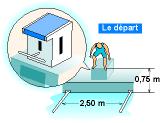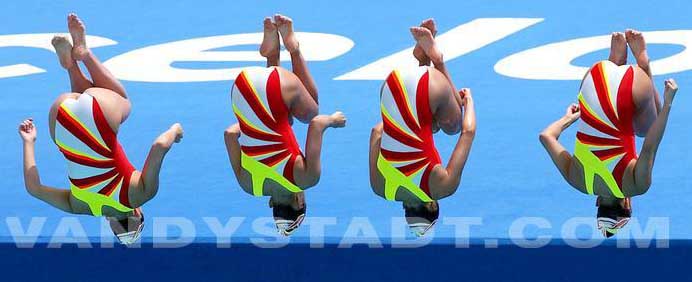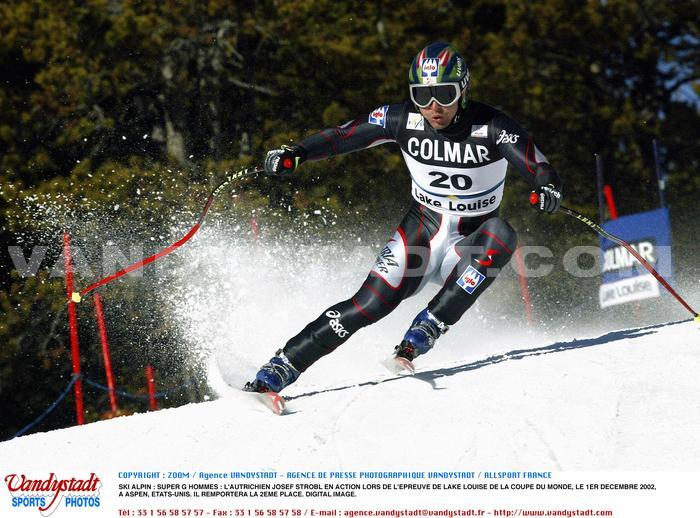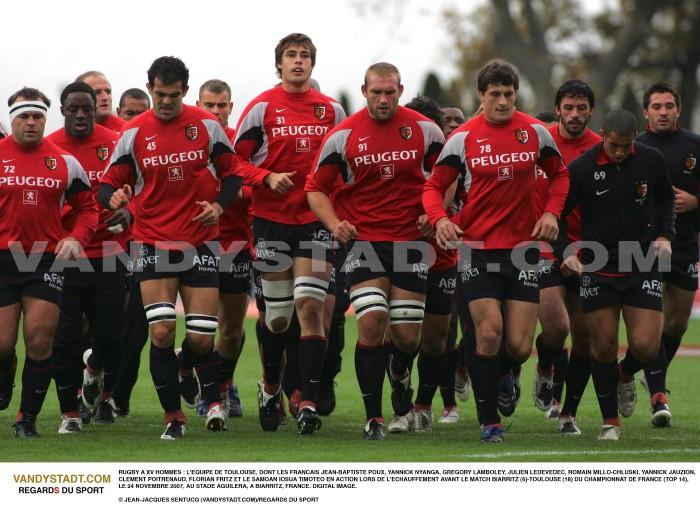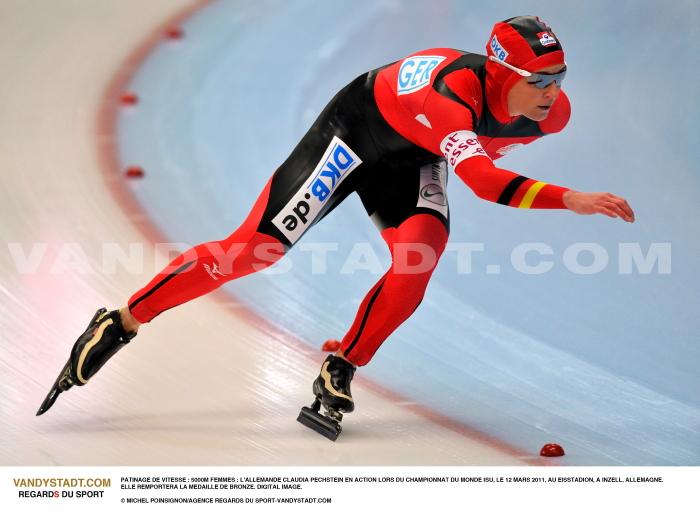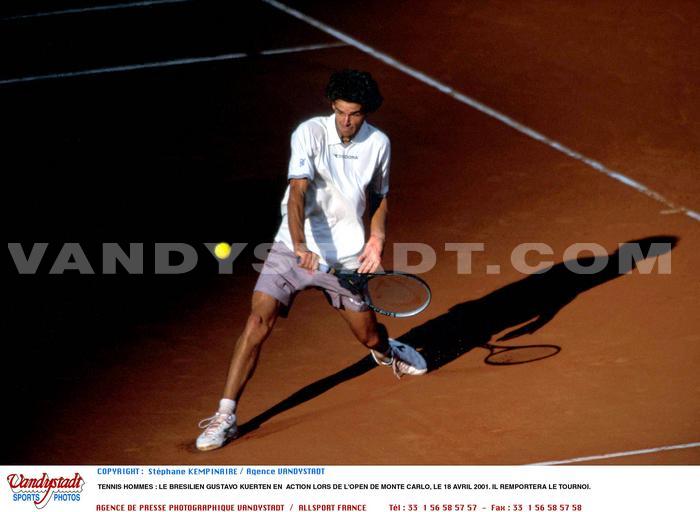Natation - Swiming history
Swimming - Olympic Sports
![]()
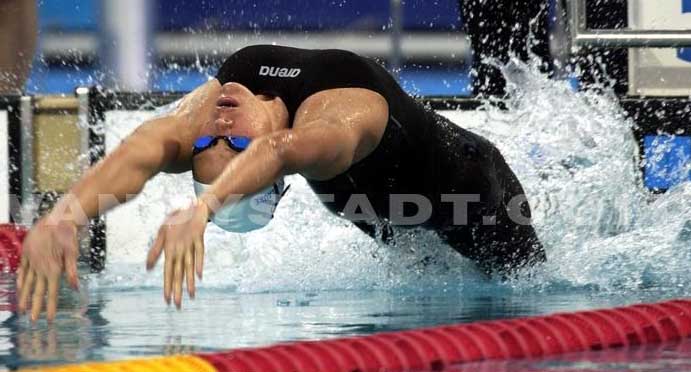
Prehistoric man had to swim to cross rivers and across lakes.
History
Found in Greek mythology references to swimming: Leander who swam across the Hellespont to find Hero. The Greek historian Pausanias describes swimming events.
Already in Rome (Julius Caesar was a good swimmer) and Japan during the reign of Emperor Sugui in the year 36 BC, took place in swimming races. It was also Japan that the first, in 1603, instituted inter-school races.
The rise of the swimming world was made in London in 1837 with the first races of swimming (breaststroke was the most practiced movement), organized by a sports club: the National Swimming Association. "In 1846 in Sydney, Australia , was organized the first championship for a distance of 440 yards (in 8 minutes and 43 seconds). In 1858, near Melbourne in St Kilda, was born the first world championship, February 9 at 100 yards. Its winner was Australia's Jo Bennett
On January 7, 1869, the first association club was born in London: Association of Metropolitan Swimming Club. On February 11, she first defined the rules of competitions under the auspices of one of Mamre, W. Ramsden. In 1889 the first European Championships were held in Vienna, at one distance, the 1500m won by Austrian Von der Strass.
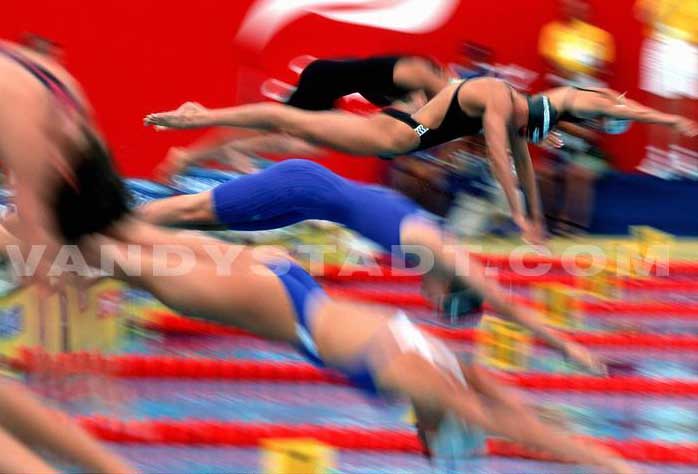
The first record approved by Metropolitan Swimming Association (London Club) was built in 1871 by
English Winston Cole's 100 yards in 1'15.
The Federation Internationale de Natation Amateur (FINA) was founded in 1908 by ten nations (Germany, Great Britain, Belgium, Denmark, Finland, France, Hungary, Ireland, Wales and Sweden), it has 179 member countries.
Milestones in swimming
- 1875: Captain Matthew Webb was the first to cross the Channel (between Dover and Calais 21h45min.) Using a new technique, swimming 'Trudgeon' (named after Arthur Trudgeon, swim coach, who brought the technique of South America), an alternative to crawl in with beats scissors.
- 1893: Looking for swimmers of Solomon Islands who moved in the water using a flapping legs stretched nearly the Englishman Frederick Cavill (emigrated to Australia) this movement taught his son six. Charles was the first to cross the 'Golden Gate' at San Francisco Dick beat the world record of 100 yards in 1902. This movement became the famous Australian crawl.
- 1904: The Hungarian Zoltan Halmay became Olympic champion in the 50 and 100 yards using front crawl.
- 1912: The Hawaiian Duke Kahanamoku introduced the front crawl (with a beating that left from the hip and by moving his arms above his head) in competition at the Summer Olympics in Stockholm. The American Harry Hebner is the first to swim backstroke.
- 1922: American Johnny Weissmuller , the future Tarzan on screen, is the first to swim the 100m in less than a minute (58 "6). He's breathing rhythm on his arm movement.
- 1926: First European Championship on several distances, the triple Olympic medalist, the American Gertrude Ederle became the first woman to successfully cross the Channel (between Cape Nose in Pas-de-Calais and Kingsdown) in 14h31min ; the German Erich Rademaher invented the butterfly Stirred (breaststroke with a return air with both arms).
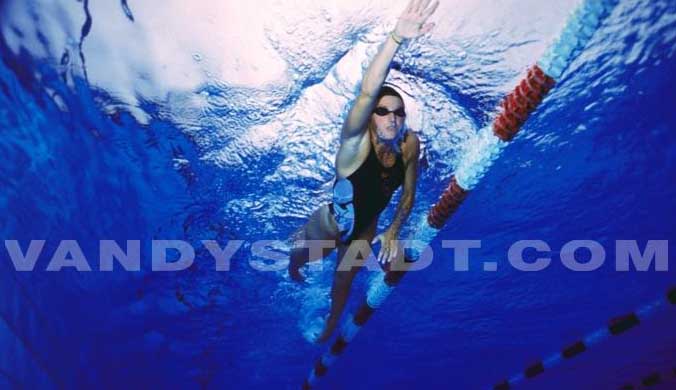
- 1933: American Henry Meyers invented the butterfly.
- 1946: FINA banned to spend butterfly breaststroke in the same event.
- 1962: The Australian Dawn Fraser is the first woman to swim the 100m in less than a minute (59 "9).
- 1964: FINA approves turn somersaults in the form of freestyle.
- 1972: American Mark Spitz achieved a unique feat by winning seven gold medals including 4 in
iduel, the Olympic Games.
- 1973: First World Championship.
- 1976: American Jim Montgomery became the first man to swim the 100 meters in under 50 seconds (49 "99).
- 1985: American Matt Biondi was the first to swim the 100 meters in under 49 seconds (48 "95).
- 1992 and 1996: The Russian Alexander Popov scored twice in 50 Olympic and 100 freestyle.
- 1998: FINA prohibits false starts.
- 2001: Australian Ian Thorpe became the winningest swimmer in world championships with 8 gold medals, including 6 wins in 2001. That same year, the Russian Roman Sloudnov became the first to drop below the original 100 m breaststroke (59 97).
- 2002: American Natalie Coughlin became the first woman to go below the original 100 backstroke (59 58).
- 2008: American Michael Phelps becomes most successful athlete at the Olympics with 11 gold medals. It thus exceeded legends like Carl Lewis (9 titles in athletics), Mark Spitz (9 titles in swimming), Paavo Nurmi (9 titles in athletics) and Latissa Latinina (9 titles in gymnastics).
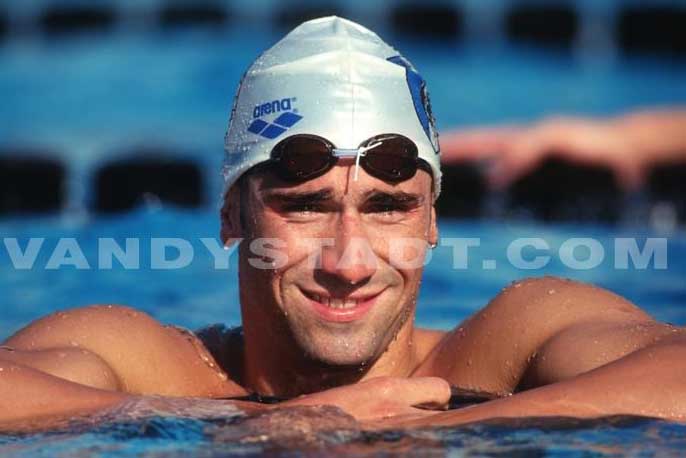
The first successful global French swimmers
- 1930: Jean Taris swim the 800m freestyle in 10 minutes 19 seconds and 6 / 10 (world record) and Yvonne Jeanne swim the 500 breaststroke in 9 minutes 45 seconds and 4 / 10.
- 1952: Jean Boiteux becomes the first French Olympic swimming champion, winning the 400m freestyle in 4 minutes 30 seconds and 7 / 10. Gilbert Bozon won the silver medal in the 100 backstroke by beating the world record.
- 1964: first Olympic medal (silver) for a French swimmer Christine Caron in the 100 backstroke in Tokyo. Alain Gottvalès beats the world record of 100m in 52 "9.
- 1967: Alain Mosconi beat the world record in the 400 m 4'9 "2.
- 1993: first title of world champion 25-meter pool for a French swimmer Franck Esposito in the 200 butterfly.
- 1998: Roxana Maracineanu becomes the first French world champion large pool by winning the 200 backstroke.
- 2003: Virginie Dedieu gets its first gold in solo synchronized swimming world championships followed by two palnétaires titles in 2005 and 2007.
- 2004: Laure Manaudou became Olympic champion in the 400m, the second gold medal of the French swimming after that of Jean Boiteux obtained in 1952.
- 2008: At the European Championships, Alain Bernard became the fastest swimmer in the world by beating the world record in 47 "60 and then after a day in 47 '50.
- 2008: Alain Bernard won the gold medal in 100 m distance queen Games. This is the third Olympic gold medal for swimming French.
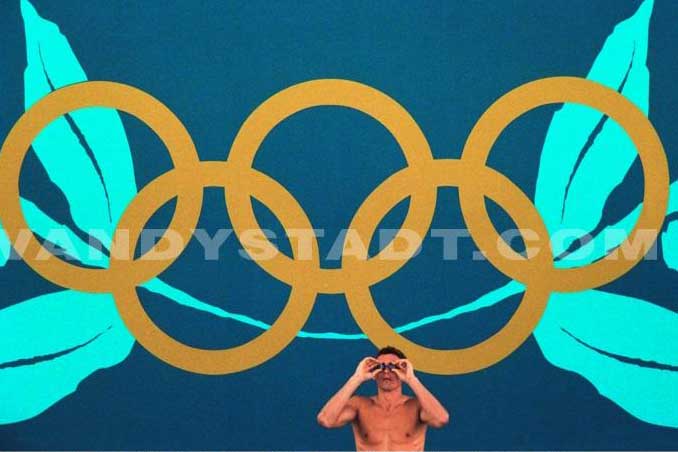 .
.
Swimming and Olympism
It is a sport of kings games.
By 1896, swimming was presented at the Summer Olympics with the 100 meters, 500 meters and 1200 meters down to sea (Mediterranean). The areas most
ers have been used as Olympic venues, from the 100m pool created for the London Olympics in 1908 which was in the middle of the athletics track, to the ocean (1896), a small lake of St . Louis, USA (1904) or the Seine (1900).
The first pool of 50 m with lanes was built in 1924. The starting blocks are from 1936.
The women's swimming made its Olympic debut in 1912. Today, competitions for men and women each have 16 events medley combining several distances.
The first Olympic swimming champion was the Hungarian Alfred Hajos , winning the 100m in 1896.
Early history
"The desire to survive was stronger than that to win."
The words of Alfred Hajos
, after winning the 1200 meters freestyle, the first modern Olympics in Athens in 1896. It was the first to reach shore from a boat stationed in the middle of the cold waters of the Mediterranean.
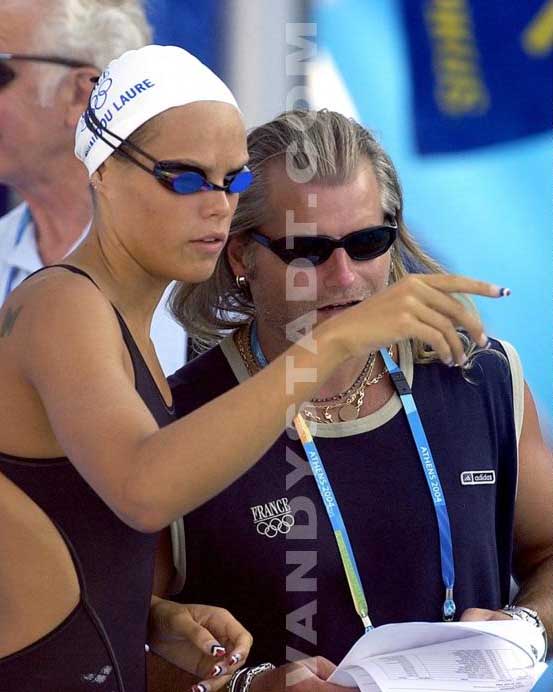
Records
The first record of 100 m was recognized by the International Federation in 1905 followed by other records in other distances. The short course records have been found in March 1991.
Competition
Swim a distance in the shortest time.
Each race takes place among eight swimmers. Heats of 50 m, 100 m and 200 m lead to semi-finals and finals on the basis of the best times. For relay events and for testing in
iduelles 400 meters or more, the eight competitors with the fastest times in the playoffs are directly qualified for finals.
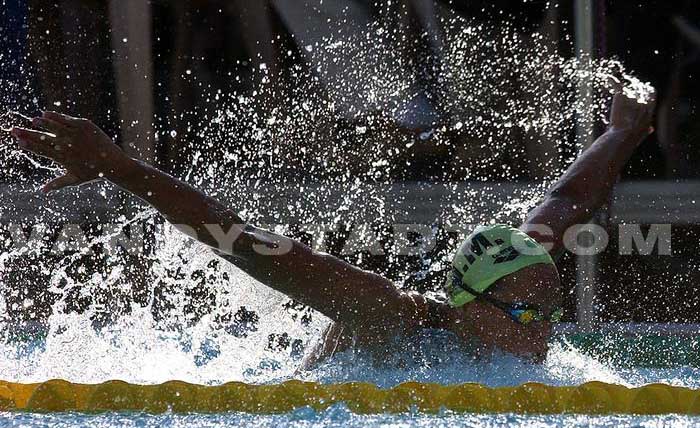
There are 4 strokes
- Freestyle: swim faster in the stomach characterized by an alternating movement of arms and flapping continuous vertical feet, known originally as the Australian crawl. Distances: 50, 100, 200, 400, 800 and 1500 meters. butterfly: 50, 100 and 200 m
- Butterfly: Swimming on the belly where the two arms come together and water are thrown forward, while executing a beat dolphin with legs. Distances: 50, 100 and 200 m.
- Dos: swimming in which the swimmer is on his back and beat feet by running an alternating rotation of the arm backwards. Distances: 50, 100 and 200 m. It swam the slowest
- Breaststroke: Swimming on the belly in which both hands move simultaneously forward, outward and backward starting from the chest and legs when performing a movement of frog. Distances: 50, 100 and 200 m
Very complex, the breaststroke requires high energy expenditure. The swimmer must synchronize the movements of the arms and legs, this perfectly harmonisation.C is swimming the slowest.
Good to know:
The prestigious U.S. college NCAA championship is held in tanks of 25 yards or 22.86 m. The starts, turns and flows require impeccable technique.
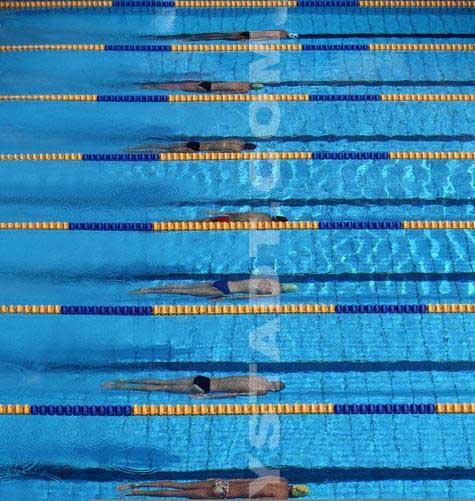
In competition, there ay other three tests:
- Medley: a combined event in which a swimmer or relay team swims sections separated from the back, breaststroke, butterfly and freestyle. Distance: 200 and 400 m.
- Relay: a race between several teams of 4 swimmers, each swimmer doing a section of the test.
- 4 Medley Relay: a race between several teams of 4 swimmers, each swimmer doing a section in the following order: backstroke, breaststroke, butterfly and crawl.
Since March 1991, there are an array of records in 50-meter pool and one for the record in 25 meter pool, which, given the advantage of more frequent attacks on the walls, are faster.
Basin
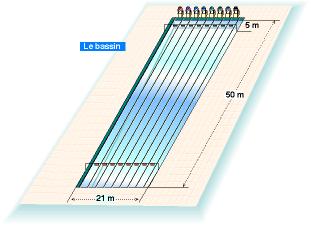
- Length: 50 m - Width: 21 m (minimum) - Depth: 1.80 m - Number of lanes: 8 - Beam Corridor: 2,50 m each, with two spaces of 50 cm (0.50 m) everyone outside lanes 1 and 8 - Temperature: + 24 ° C / 77 ° F
Now the port of combinations of high-tech, full-fabric 'sharkskin' (polyurethane) is allowed in official competition. This combination covers the body except the feet, hands, shoulders and head. These shirts have revolutionized swimming and have resulted in more than a hundred world records in just over a year in 2008. A rule of FINA, established in March 2009, states that the suit must conform to the shape of the body, the materials should not be thick more than 1 mm, buoyancy is limited and swimmers may wear only one suit. Combinations 'style or Arena Jaked X-Glide' is not allowed in official competition, because it is fully waterproofed for better buoyancy. The ten world records established in early 2009 by swimmers wearing this combination in question are not approved by FINA (50 m by Bousquet FRA in 20s94, 100 m by Bernard FRA in 46s94, 200 backstroke by Irie in Japanese 1mn52s86, 50 m breaststroke by Franca BRE in 26s89 then 50 m butterfly by Munoz PSE 22s43 men , 50 m by Veldhuis HOL in 23s96, 200 m by Pellegrini ITA in 1mn54s47, 50 backstroke by RUS in Zoueva 27s47, 50 m breaststroke by RUS in 30s05 Efimova, 50 m butterfly by Veldhuis HOL 25s33 in women)
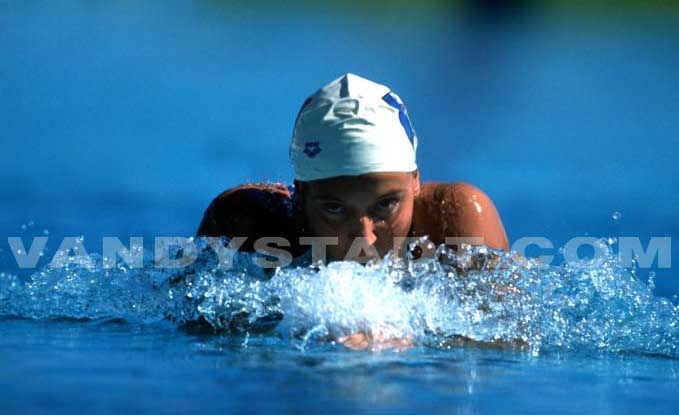
Fathom
Very complex, the breaststroke requires high energy expenditure. The swimmer must synchronize the movements of the arms and legs, this perfectly harmonisation.C is swimming the slowest.
1. The body must remain completely lying on his stomach, and shoulders should be parallel to the surface of the water early in the first arm stroke after the start and turn.
2. All movements of the arms and legs must be simultaneous and in the same horizontal plane without alternating movement.
3. Hands should be elongated together from the breast, and brought back to the surface or subsurface water.
4. For the movement of legs, feet must be turned outwards in the return movement. A motion of dolphin is not allowed.
5. In turn and finish, the competitors must touch the rim with both hands simultaneously at the same level, above or below the water level. The shoulders must be horizontal.
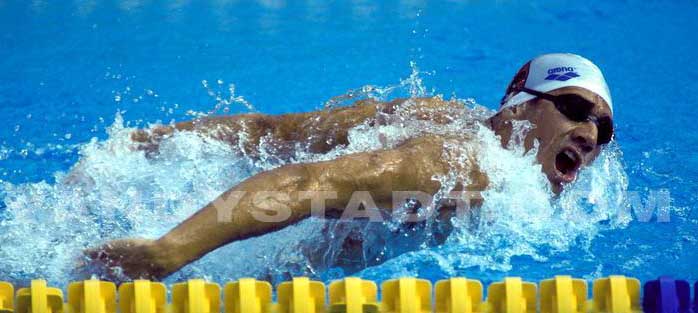
The butterfly
The youngest subject was introduced to swimming at the Olympic Games in 1956 for the 200 m and 1968 for the 100 m.
1. The arms should all be thrown forward over the surface of the water and brought backward simultaneously.
2. The body must remain completely lying on his stomach, and shoulders should be parallel to the surface of the water early in the first arm stroke after the start and turn.
3. All movements of the feet must be executed simultaneously. The simultaneous movements of legs and feet from top to bottom in a vertical plane are allowed. It is not necessary that the legs or feet are at the same level, but no alternating movements are permitted.
4. In turn and finish, the competitors must touch the rim with both hands simultaneously at the same level, shoulders remaining in a horizontal position. Contact can be above, below or at the water.
5. At the start and at turns, the swimmer is allowed to make one or more leg kicks and one arm pull under water, returning to the surface.
Since 1998, flows in butterfly and backstroke are limited to fifteen meters after the start andTHE turn.
Single starting
Since 1999, a swimmer who made a false start will be automatically removed. The other competitors back on the block to get a second start.
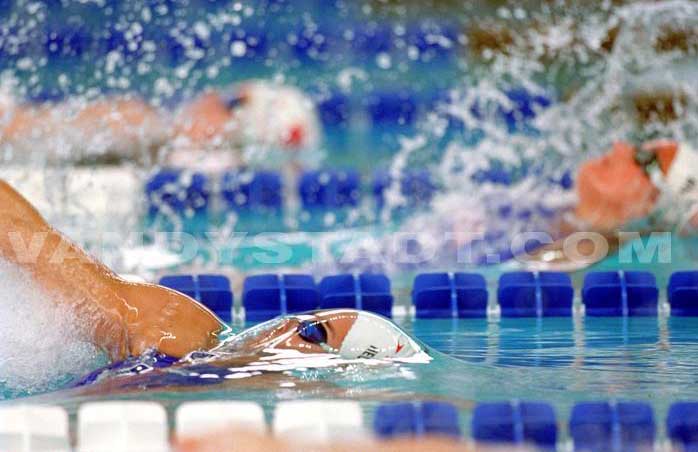
Backstroke
1. Contestants line up in the water facing the starting hands placed on the stirrups of departure. The feet, including toes, should be under water. It is forbidden to set foot in or on the chutes, or bending the toes over the edge of the chutes.
2. At the starting signal and turn, they repel the wall and swim on his back throughout the race. The hands must not let down the stirrups before the starting signal was given.
3. Any competitor leaving his normal position on the back before the head, the most advanced hand or arm has reached the end of the trail in order to transfer or on arrival, will be disqualified.
It is allowed to return beyond the vertical after the most advanced part of the body touched the wall in order to execute the turn, but the swimmer must have passed the vertical and regained its position on the back before that the feet never leave the wall.
Freestyle
Freestyle means that in an event so designated, the competitor may swim any style of swimming, in a medley relay or individual medley event in
iduelle the freestyle means any style other than butterfly, breaststroke or back. In turn and finish in freestyle, the swimmer can touch the wall with any part of his body. It is not required to touch his hand.
Namely:
The Crawl, sprint swimming, was born in a swimming pool in Sydney in 1898 on bases in Hawaii. The backstroke was created a few years later, inspired by the crawl. It was practice for the first time the Olympic Games of 1924 by the legendary Johnny Weissmuller .
The Australian is a tournament that competes speed of 50 m, swimming changing at every turn (butterfly, backstroke, breaststroke and front crawl).
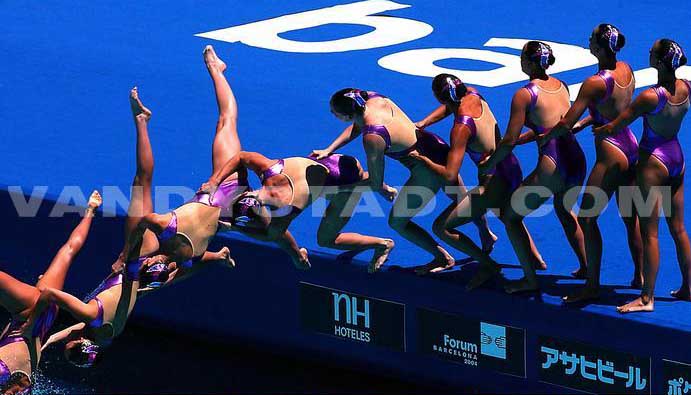
Medley
Originally three swims until 1953. The swimmer combines the techniques of four strokes over a length of basin. The four styles are: breaststroke, butterfly, back and freestyle.
- In order to
iduel: 1. Butterfly - 2. Back - 3. Breaststroke - 4. Freestyle (any style other than butterfly, breaststroke and back), the technique most used is the crawl.
- Order relay: 1. Back - 2. Breaststroke - 3. Butterfly - 4. Freestyle.
Distance recognized
- Freestyle: 50 m, 100 m, 200 m, 400 m, 800 m and 1500 m
- Dos: 50 m, 100 m, 200 m
- Breaststroke: 50m, 100m, 200m
- Butterfly: 50m, 100m, 200m
- Medley: 200 m, 400 m
- Freestyle Relay 4 x 100m, 4 x 200 m
- Medley Relay: 4 x 100 m
A mixture of strength, endurance and flexibility, grace and artistry, but also exceptional control of his breathing.
History
Recent discipline inspired swimming, dance and gymnastics, it affects mainly girls.
Originally known as the water ballet, synchronized swimming made its debut in Canada in the 1920s. It then spread to the United States in the early '30s, where a demonstration at the fair in Chicago in 1934 has led to rave reviews. Its popularity soared further in the years 1940 and 1950 when Esther Williams starred in a series of musicals from MGM's aquatic
Synchronized swimming and Olympism
A first demonstration was given by an American team at the Helsinki Olympics in 1952, the year of recognition by the International Federation. Synchronized swimming became an Olympic sport in 1984 (solo and duet). A test team of 8 swimmers replaced the solo since 1996. For all tests, the competition has a routine and a free routine, each performed to music and limited time. In the technical routine, swimmers perform specific moves imposed in an order, including boosts, rockets, thrusts and twirls. In the free program, there are no restrictions on music or choreography.
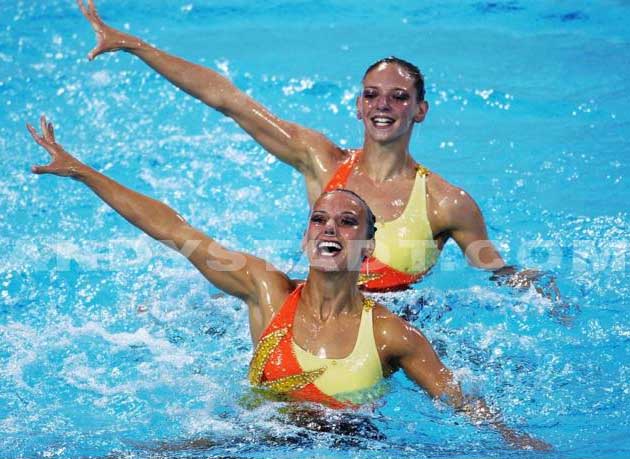
Key Dates:
1941: First global competition in Wilmette (duet, team).
1948 to 1968: demonstration sport at the Olympics.
1950: First championship of France.
1952: Integration of sport within the NAFI at the Helsinki Olympics.
1956: FINA ratified by regulation.
1973: First World Championships in Belgrade, Yugoslavia.
1974: First European Championships in Amsterdam, Netherlands.
1983: First World Cup in Tokyo, Japan.
1984: First Olympic Games in Los Angeles, USA.
The three major figures of the synchronized swimming were: Australian Annette Kellerman (1886-1975) performing acrobatics in a transparent tank in the Hippodrome in New York in 1907, the gymnast Katherine 'Kay' Curtis, whose ballet 'Sirens 'with underwater stunts performed by 60 swimmers with music gained a great success and of course the unforgettable California Esther Williams, became a movie star with her water ballet brought to the screen in the 40s.
Competition
There are three different events: solo, duo and ballet team.
Swimmers have two programs:
- A technical program. Duration: 2 min solo - 2 min 20 duo - 2 min 50 team. The judges give a score for the technical accounting for 60% and a note for the artistic accounting for 40%.
- A free program. Duration: 3 min 30 solo - 4 min duo - 5 min team. The technical notes account for 40%, the artistic mark account for 60%. In the free skate, 10 seconds or less are awarded for work around the bay (beach time).
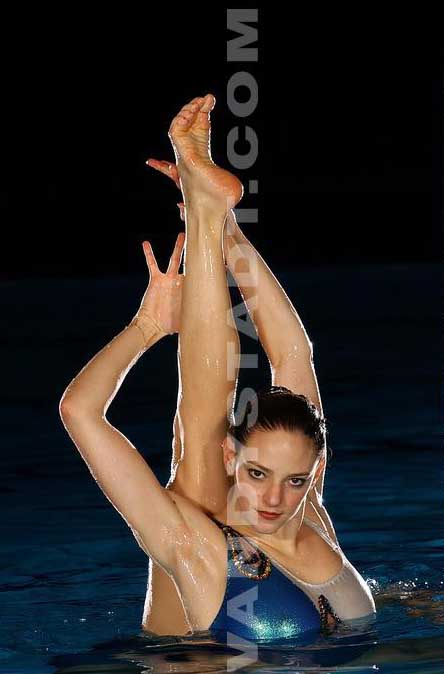
- The size of the basin is 20 m by 30 m, depth 3 m, and temperature: 26 ° C
- Loudspeakers broadcast the music underwater.
- Swimmers wear nose plugs to prevent water from entering the nose and sinuses protecting.
Good to know: the swimmers are about 70% of program apnea.
Notation
Judges take into account the quality of the choreography, aesthetics and the technical difficulty of figures performed. The free program is equivalent to 65% of the result, the technical program account for 35%.
Until 1994, scores of 0 to 10, assigned by 7 judges took into account the benefits and imposed free. Since 1995, the compulsory figures are removed during the world championships and Olympics.
Diving
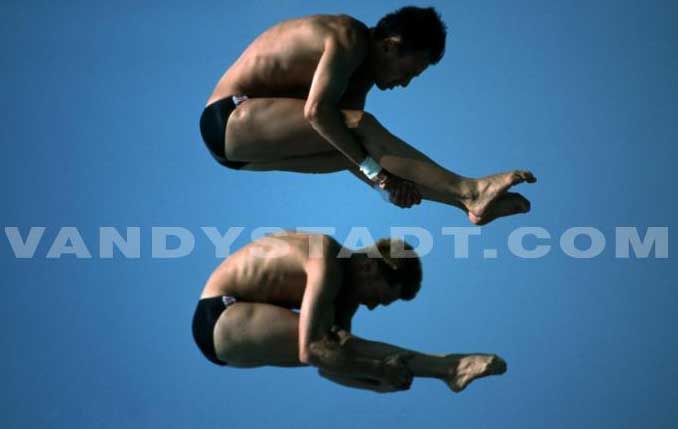
History
Jump into water from a springboard or platform diving was once practiced by the Vikings. The dive was part of the artistic gymnastics programs conducted in Sweden and Germany in the early 19th century. The first rules were published in Germany in 1843. In the late 19th century, Swedish divers have made diving demonstrations in Britain. The 'Amateur Diving Association' was founded in 1901. It must however wait until 1904 for the development of a table of coefficients of the types of dives and their degrees of difficulty.
At the world championships of 1995, a new test has emerged in some competitions: the synchronized diving, which involves two divers on the same team. They perform their figures from a separate platform and, in addition to the traditional criteria for trial, they are also graded on their timing.
.jpeg)
Diving and Olympism
The top flight was scheduled for the first time the Olympic program in 1904 for men. The women's diving is entered in the Olympic program in 1912 (top flight) and 1920 (springboard). The heights of platforms and platform differed in the first competitions of the Games, they have stabilized since 1928. The synchronized diving at the top flight in springboard became an Olympic sport in 2000.
Competition
Divers are required to perform acrobatics, judged both on technical difficulty and quality of implementation of their performance in space. "Attitude" when entering the water is paramount.
Officially, there are some 91 variations of high-flying jumps and 70 in 3m springboard, which are divided into five groups (6 for the top-flight). A jump is distinguished by its shape (tuck position, free, pike, diving forward, backward, inverted), number and difficulty (somersaults with twists, rotates 360 ° or 180 °), the descent into the water (head or feet).
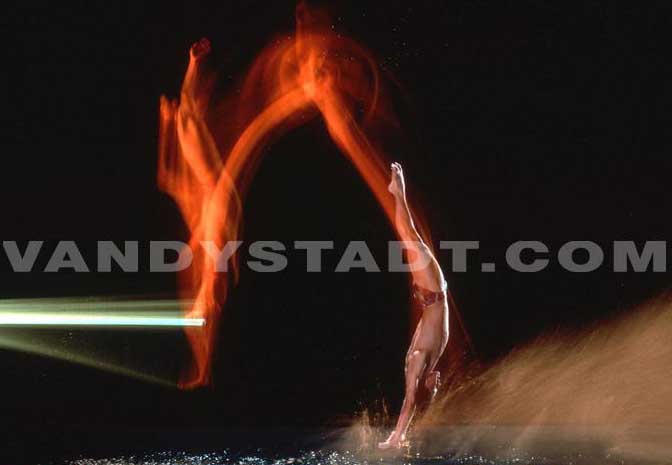
In an official competition, a jet of water flows through the basin at the foot of diving. The aim is to 'break' the surface of the water so that divers can better gauge the distance they still have to go before people catch the hands enter the water.
Three events are on the agenda of (en solo ou en synchro) :
-- the boards 1 and 3 meters
-- platform of 10 meters (top flight).
Platform (High Vol)
To the top flight, the board must be at least six feet long and two meters wide, with an anti-slip surface. For the synchronized diving, the platform must be at least three meters wide.
Springboard
It is a flexible plate from where the dive and the length of which may be to create more or less clear. Minimum length: 4.8 meters and width: fifty centimeters, with an anti-slip surface.
Basin Depth : Minimum 5 feet
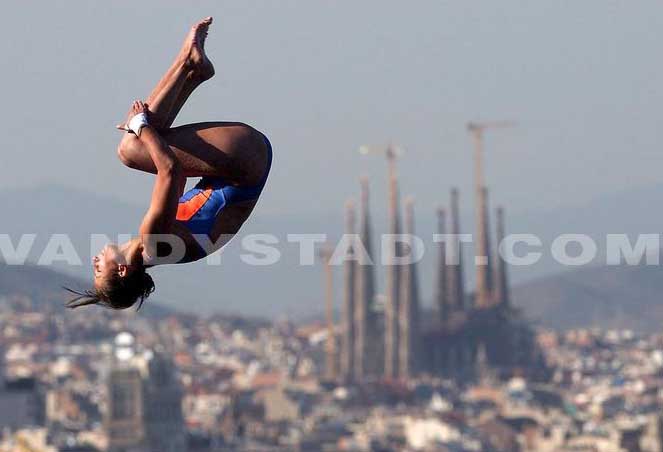
Arbitration
Competitors perform a series of dives recorded on 10 as the elegance and skill. The points are adapted to the degree of difficulty, depending on the number and type of maneuvers attempted, such as somersaults, jumping carp, jumps and spins grouped.
- Seven judges noted the plunge, considering each element as the approach, takeoff, execution and entry into the water.
- New judges evaluate the synchronized diving, four judges for the achievement of dives in
iduels and five for synchronization (how the pair reproduces the height, distance from the board or platform, speed of rotation and entry into the water).
One and a half somersault with three inverted spins and a half is one of the most difficult.
Did you know
Divers enter the water at about 60 mph in top-flight is a pressure of one ton.
It must pass 42 steps to climb up the platform.
Flying time is one second eight (the ultimate limit to unfold before touching the water is 50 cm).
Youth Records
- The youngest Olympic champion in an event in
iduelle the U.S. is Marjorie Gestring winning gold in diving in 1936 at only 13 years and 268 days.
- The youngest Olympic medalist in a test in
iduelle the diver is Swedish Nils Skoglund after winning Olympic silver in top flight in 1920 to 14 years and 11 days!
Copyright Sportquick/Promedi








